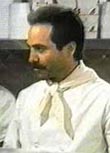|
|
This topic comprises 2 pages: 1 2
|
|
Author
|
Topic: Light cues
|
|
|
|
|
|
|
John Pytlak
Film God

Posts: 9987
From: Rochester, NY 14650-1922
Registered: Jan 2000
|
 posted 10-25-2001 08:40 PM
posted 10-25-2001 08:40 PM





I second the use of a soft foam strip, rather than a core or other hard material that could scratch the film. The foam makeup applicator wedges work (check a beauty supplies store), or use foam weatherstripping material. "Nerf" balls cut into 35mm cubes could also be used. All you are doing is trying to leave a gap in the roll at the cue/splice you need to work on after the film winds up.If there is a sticky residue after the foil tape is peeled off, carefully wipe off the adhesive with a bit of film cleaning solvent. ------------------
John P. Pytlak, Senior Technical Specialist
Worldwide Technical Services, Entertainment Imaging
Research Labs, Building 69, Room 7525A
Rochester, New York, 14650-1922 USA
Tel: 716-477-5325 Cell: 716-781-4036 Fax: 716-722-7243
E-Mail: john.pytlak@kodak.com
Web site: http://www.kodak.com/go/motion
| IP: Logged
|
|
|
|
|
|
Ray Derrick
Master Film Handler

Posts: 310
From: Sydney, Australia
Registered: Sep 2001
|
 posted 10-26-2001 08:05 PM
posted 10-26-2001 08:05 PM




Fair comment, Jesse.The most common cue arrangement I have seen in Australia is to place the foil horizontally along the frame line. Thus for widescreen it is out of the picture and does not affect the soundtrack, (provided it is not cut too long), and if carefully placed will have minimal visibility in scope. The worst I have seen is placing it vertically down the middle of the frame, that looks grotesque on screen! Placing it down the side usually means covering part of the soundtrack and/or making the foil less stable and have less area because of sprocket hole cutouts. Wrapping it round the edge is a common practice but this can lead to foils falling off due to the natural tendancy for the foil to want to straighten itself out, and it's greater exposure to film transport components. Of course if you are stuck with using an inboard or outboard cue detector you don't have much choice. Also I should point out that very few cinemas place splicing tape over the foils here (it is normally not necessary) and this is probably due to the widespeard use of "centre" cues only and maybe the use of better quality foil. This is something that may be worth investigating, maybe a cue foil shootout?
------------------
Ray Derrick
President
Panalogic Corporation Pty Limited
44 Carrington Road
Castle Hill NSW 2154
Australia
Phone: 61 (0)2 9894 6655
Fax: 61 (0)2 9894 6935
| IP: Logged
|
|
|
|
|
|
|
|
|
|
Brad Miller
Administrator

Posts: 17775
From: Plano, TX (36.2 miles NW of Rockwall)
Registered: May 99
|
 posted 07-19-2004 04:05 AM
posted 07-19-2004 04:05 AM




quote: Wolff King Morrow
What has been aggravating me to no end is that these foils last on average of about 7 to 10 days before the detector decides to ignore them. So every other day I'd have to run around to various prints and replace cue strips in order to keep the lights on time.
That just SCREAMS Strong CNA automations with those evil Eprad cue detectors. Am I right? Am I right? I just know I am right. I am right, aren't I? I just have to be right. Those SUCK!!! (And I'm being very nice about my true feelings.) Never has a more unreliable system been devised.
A few tips for whatever it's worth...
*Don't call Strong for assistance! Every bit of advice and help you get from them will make the problem worse, guaranteed! By following their advice, in no time you will have projectors shutting down randomly during shows, amongst other problems. After giving up on the whole "ask the manufacturer" idea, I started running my own tests and found the following points that worked pretty well...
*Assuming you have non-operator side oriented Strong platters, from time to time I'll bet during threading the elevator goes slamming into the top of it's travel. Of course it does. It's a Strong platter! Note that can cause the guide rollers on that POS cue reader to get bent downward on the outboard edge. This means your sensor is slowly getting pulled farther and farther away from the film. Also, if the lower magazine roller is getting knocked toward the platter, that will further cause the film to buckle in the cue reader and exaggerate things even worse. Be prepared to go in and bend that shaft back every so often, and make sure your rollers are properly aligned. The better solution is to gut the cue reader and reorient it such that it scans cues on the inboard edge. That will lessen those problems substantially! Of course an even better solution is to purchase a real cue detector such as made by Kelmar or CE and be done with it.
*Use ONLY Neumade's "Aucuta II" cue strips with those demonic readers. These are about 4 inches long and will provide the longest lifetime of any other cue tape on the market. Believe me, I've tried them all. Any cue tape that comes on a roll will NOT function with the Strong automation system for any length of time. You have to have those Aucuta II strips to get any lifespan.
*Do not fold the tape over the edge. Lay it down up against the SRD track (but don't interfere with it) on the emulsion side of the film and then using a pair of sharp scissors, trim the cue tape flush with the edge of the film. This will help to permit it to curl back and forth moreso in the projector and all those super tiny rollers Strong likes to use on their platters.
*Activate that "cue memory" feature thing Strong puts in their automations. Remember it's there for a reason, because they KNOW their system sucks and they KNOW it will miss cues, so instead they have this clock/timer thing built in to memorize when the cues are supposed to hit and even though it doesn't see the cues, it initiates the command anyway. That way the system appears to work all of the time and corporate people who don't actually work in the booth will be fooled into believing that the system does the job and thus they will keep purchasing them for new locations. Yes, yes, yes, it's all in the master plan to make projectionists' lives a living hell.
*Seek out whoever invented that cue detector and automation and beat them to a bloody pulp. It won't fix your problem, but at least you will feel better about it. Let me know before you book your flight. I'll go with you and hold the bastard down. I've put up with more than enough bullshit from that automation system to deserve that honor.
| IP: Logged
|
|
Carl Martin
Phenomenal Film Handler
Posts: 1424
From: Oakland, CA, USA
Registered: Feb 2002
|
 posted 07-19-2004 04:30 AM
posted 07-19-2004 04:30 AM





quote: Dominic Espinosa
I've even put an intermission cue so small it fits comfortable between perforations and it still works without coming off.
hmm, i once tried trimming our cue tape a little narrower to make it less visible on scope films (we lay it on the frameline, into the picture area, depending on the cue), to about 1/8" wide. it worked just fine for the test screening, but various cues failed for most of the real shows. i even tried putting another narrowed cue on the very next frameline as well, but even that was unreliable. so much for that.
oh, we use fm-35/37's, don't know what brand of foil tape.
carl
| IP: Logged
|
|
|
|
|
|
|
|
All times are Central (GMT -6:00)
|
This topic comprises 2 pages: 1 2
|
Powered by Infopop Corporation
UBB.classicTM
6.3.1.2
The Film-Tech Forums are designed for various members related to the cinema industry to express their opinions, viewpoints and testimonials on various products, services and events based upon speculation, personal knowledge and factual information through use, therefore all views represented here allow no liability upon the publishers of this web site and the owners of said views assume no liability for any ill will resulting from these postings. The posts made here are for educational as well as entertainment purposes and as such anyone viewing this portion of the website must accept these views as statements of the author of that opinion
and agrees to release the authors from any and all liability.
|

 Home
Home
 Products
Products
 Store
Store
 Forum
Forum
 Warehouse
Warehouse
 Contact Us
Contact Us




 Printer-friendly view of this topic
Printer-friendly view of this topic




















